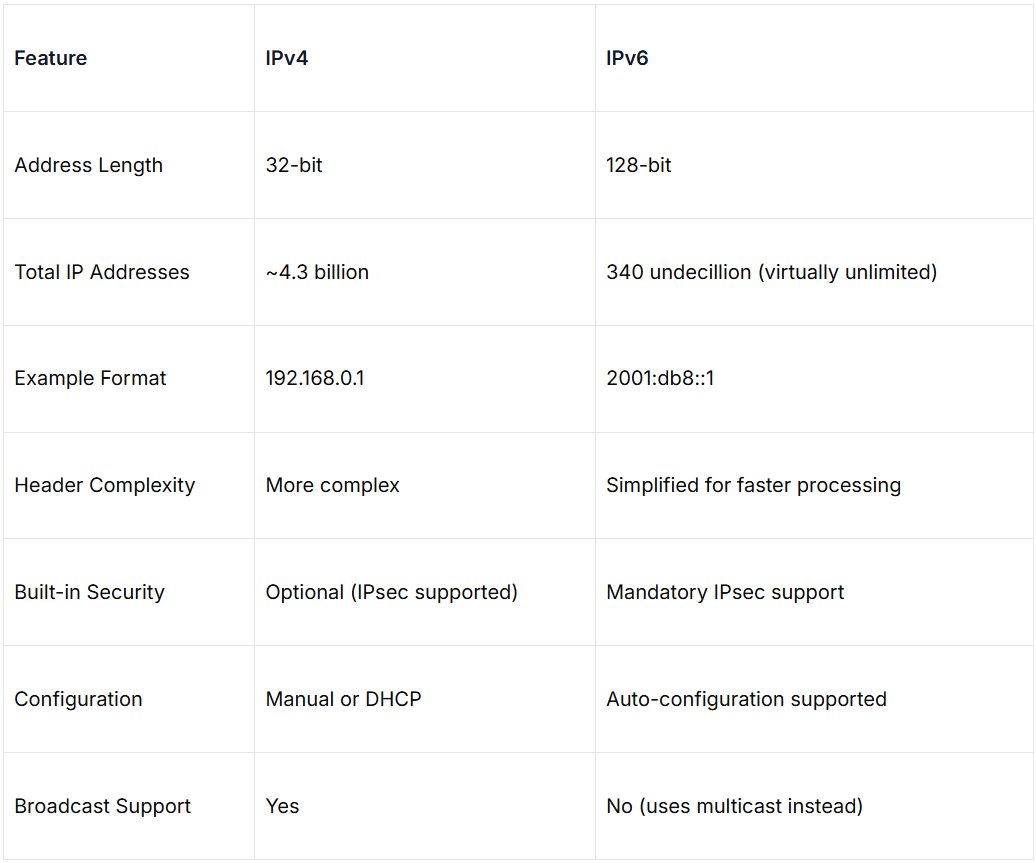What Is the Difference Between IPv4 and IPv6?
Every device connected to the internet needs a unique address to communicate, just like every home has a postal address. These digital addresses are called IP (Internet Protocol) addresses. For years, IPv4 has been the backbone of online communication. However, with the rapid increase in connected devices, a new version – IPv6 – was introduced to solve the shortage of IP addresses and improve overall network efficiency.
IPv4, the fourth version of the Internet Protocol, uses a 32-bit system and provides around 4.3 billion unique addresses. While that seemed more than enough in the past, it’s no longer sufficient due to smartphones, computers, smart TVs, and even household devices needing internet access. IPv6, the sixth version, uses a 128-bit format and supports an almost unlimited number of unique addresses – enough to assign an IP to every grain of sand on Earth and still have plenty left.
IPv4 vs IPv6: Key Differences Explained
The most significant difference between these two protocols lies in their address formats. IPv4 addresses look like this: 192.168.0.1. They consist of four sets of numbers separated by dots. In contrast, IPv6 addresses look more complex: 2001:0db8:85a3:0000:0000:8a2e:0370:7334, using eight groups of alphanumeric characters separated by colons.
Another major difference is availability. IPv4 address exhaustion pushed the internet community to seek alternatives. Companies and developers now often need to buy IPv4 proxies to ensure they have enough address space for web scraping, cybersecurity tasks, or managing multiple accounts online. IPv6 solves this issue with its massive pool of addresses, eliminating the need for sharing or recycling IPs.

Performance, Speed, and Security Comparison
IPv6 is designed to be faster and more efficient in data processing. Its simplified header structure allows routers to handle data packets more quickly. Unlike IPv4, which often relies on NAT (Network Address Translation) to allow multiple devices to share a single IP, IPv6 enables direct communication between devices without the need for translation. This reduces delays and improves performance in many cases.
When it comes to security, IPv6 includes IPsec by default. This feature offers data authentication and encryption, making communication more secure. IPv4 can also use IPsec, but it isn't built-in and must be manually added, which makes its implementation inconsistent.
Why IPv6 Isn’t Replacing IPv4 Overnight
With so many advantages, why isn’t everyone using IPv6 already? The main reason is compatibility. Many websites, devices, and network systems are still built around IPv4. Updating infrastructure takes time and money. Additionally, some older devices and software do not support IPv6, especially in small businesses or home networks.
Internet service providers and tech companies are gradually adopting IPv6, but complete transition requires both ends of a connection – servers and users – to support it. Until then, IPv4 and IPv6 will continue to coexist.
Real-World Applications and Use Cases
IPv4 remains widely used for hosting websites, connecting smart devices, and supporting legacy systems. It’s familiar, reliable, and works with almost all online platforms. That’s why many businesses still rely on it, especially when performing tasks like data collection, social media management, or SEO monitoring.
IPv6, on the other hand, is becoming crucial for modern technologies such as smart homes, IoT devices, and high-speed networks. It simplifies device communication and supports automatic configuration, which is ideal for large-scale systems involving thousands of connected devices.
Here’s a quick list summarizing when each protocol is more suitable:
Use IPv4 when working with older systems, software, or websites
Use IPv6 for modern networks, IoT devices, and long-term scalability
Combine both when creating flexible and future-ready infrastructure
Businesses can integrate services like buy IPv4 proxies to ensure stability while transitioning to IPv6
Conclusion: Which One Should You Choose?
Both IPv4 and IPv6 have their strengths. IPv4 is familiar, widely supported, and still necessary for many applications. IPv6 offers limitless addresses, improved performance, and better security. Instead of replacing one with the other immediately, the internet is moving toward a hybrid approach where both protocols work together.
Understanding the difference between IPv4 and IPv6 helps businesses and individuals make smarter decisions when setting up networks, choosing hosting providers, or planning long-term digital strategies. As technology continues to evolve, the world will gradually shift toward IPv6 – but IPv4 isn’t going away just yet.



